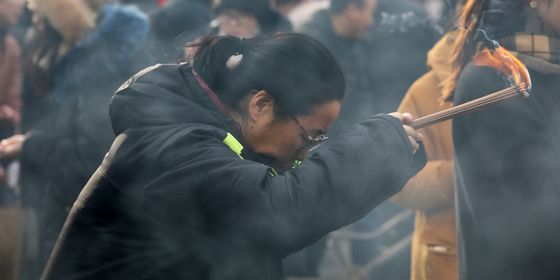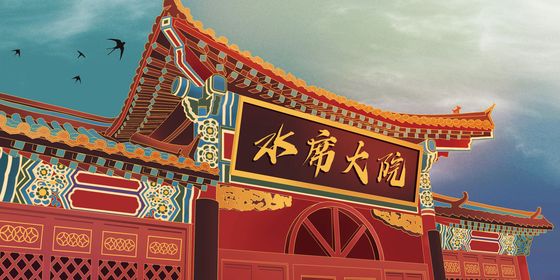A sweet, southern holiday tradition to sate your palate
One bonus of China’s vast landmass is that you can find diverse cuisines from various latitudes. If you yearn for a bite of the tropics, then you should definitely turn to the Dai cuisine (傣菜), which has its roots in the Dai autonomous prefecture of Xishuangbanna at the southern edge of Yunnan Province. Living deep among the palm trees and rainforest, the Dai ethnic group shares strong links with Thai ethnic groups in Laos and Thailand, and their cultures have a lot in common; in China they are known for their folk arts, brown-skinned beauties, and, perhaps above all else, their food, which features stunningly distinct spices and tastes.
Yu Nanwen is the hostess of a restaurant in Gadong Village (嘎栋乡), located in Jinghong City, the capital of Xishuangbanna, where Dai restaurants are concentrated. Locals flock here to experience authentic Dai cuisine.
But, Yu says it’s not easy to run a Dai restaurant: “Dai food is delicious but very troublesome to make. Most dishes involve many complicated steps.”
Yu recommends pineapple rice as a good way to start.
The dish is purple sticky rice (紫糯米) steamed in a hollowed pineapple. However, as simple as it sounds, Yu says that, in her childhood, it was always a festive treat. Even though now she makes it on a daily basis, it used to be made only during the Water-Splashing Festival (泼水节) or for special guests. This may have to do with the rareness of the purple sticky rice. For their daily staple food, the Dai ethnic people traditionally have white sticky rice instead of the purple option, because the latter is produced in limited regions in Yunnan—only Mojiang and Xishuangbanna—and is harvested only once a year.
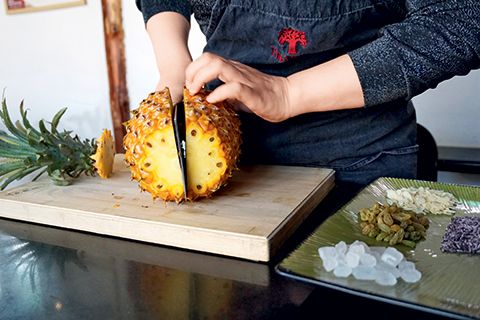
In recent years the purple sticky rice has become more well known and gradually won favor across the country. It is largely appreciated for its flavor, but there have also been claims that it has medicinal qualities. There is a saying in Traditional Chinese Medicine (TCM) that, “black benefits the kidneys” (黑入肾). In the abstract, rather unscientific style of TCM, dark purple is lumped in with the color black and, therefore, food of this color—sesame, black beans, grapes, mulberries, and, of course, the purple sticky rice—is perceived as beneficial to the kidneys.
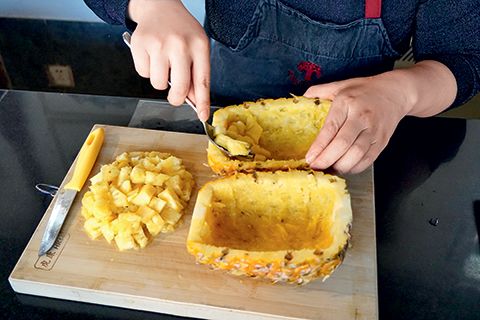
The pineapple container is natural for Dai chefs; it is a long-standing tradition to use fresh plants as cooking containers. For example, they often have rice steamed in bamboo sections, and in a cooking method called baoshao (包烧, literally “wrap and roast”), the food is wrapped in a palm leaf and roasted on charcoal. Aside from being pleasing to the eye, it is important to integrate the fragrance and taste of the container or wrapper into the food itself. The same goes for pineapple rice.

At first glance, it may seem that the Dai pineapple rice resembles the Thai version, but they are distinctly different. The Thai pineapple rice is salty in taste; contains a variety of ingredients like shrimp, green beans, and pepper; and the mixture is stir-fried with oil. The Dai version, on the other hand, is sour-sweet, oil-free, simply consisting of rice and pineapple, and in Yu’s words, “It tastes much fruitier.”
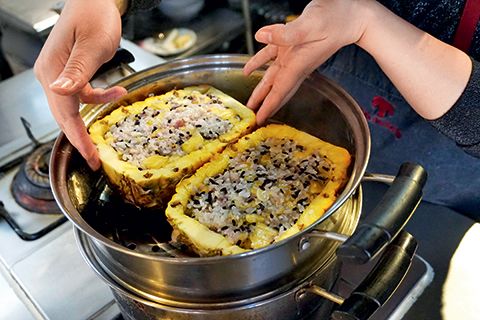
To make the dish, it is ideal to have purple sticky rice and pineapples common to Yunnan and Southeast Asia, which in China are referred to as “the eye-less pineapple” (无眼菠萝) because they are sweeter, fleshier, and do not have holes under the skin. But the most important thing is to remember that, on a Dai table, the pineapple rice is not a staple food, just a delightful after-dinner dessert; so, be sure to make it in a festive, joyous mood, the key to all good desserts.
…….
“Pineapple Rice” is a story from our latest issue, “Startup Kingdom”. To get the full recipe and continue reading, become a subscriber and receive the full magazine. Alternatively, you can purchase the digital version from the iTunes Store.









